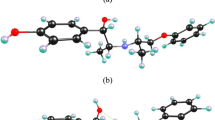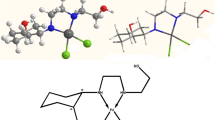Abstract
In the present work, the interaction of phosphorous heterocycle (PH) with calf thymus DNA (CTDNA) has been studied using spectroscopy and verified by molecular modeling which is found to be in consonance with each other. Apparent association constant (Kapp = 4.77 × 103 M− 1), calculated using UV–Vis spectra indicating an adequate complex formation between CTDNA and PH. A dynamic mode of the fluorescence quenching mechanism in case of ethidium bromide (EB) + CTDNA by PH has been observed confirming formation of DNA-PH complex. A moderate binding constants of PH with CTDNA + EB has been observed (2.74 × 104 M− 1 at 293 K) by means of fluorescence data. Calculated values of thermodynamic parameters enthalpy change (ΔH) and entropy change (ΔS), suggests weak (van der Walls like) force and hydrogen bonds playing the main role in the binding of PH to CTDNA. Furthermore, the results of circular dichroism (CD) reveal that PH does not disturb native conformation of CTDNA. As observed from absorption and fluorescence spectroscopy the binding mode of PH with DNA was indicative of a non-intercalative binding, which was supposed to be a groove binding. The molecular modeling results show that PH is capable of binding DNA having docking binding energy = -7.26 kcal × mol− 1. Above mentioned experimental results are found to be in consonance with molecular docking simulations and supports the CTDNA-PH binding.

Graphical Abstract







Similar content being viewed by others
References
Singh MP, Joseph T, Kumar S et al (1992) Synthesis and sequence-specific DNA binding of a topoisomerase inhibitory analog of Hoechst 33258 designed for altered base and sequence recognition. Chem Res Toxicol 5:597–607
Sparks J, Scholz C (2009) Evaluation of a Cationic Poly(β-hydroxyalkanoate) as a Plasmid DNA Delivery System. Biomacromol 10:1715–1719. https://doi.org/10.1021/bm900372x
Jw L (1988) Lexitropsins: rational design of DNA sequence reading agents as novel anti-cancer agents and potential cellular probes. Anticancer Drug Des 3:25–40
Kundu P, Ghosh S, Chattopadhyay N (2015) Exploration of the binding interaction of a potential nervous system stimulant with calf-thymus DNA and dissociation of the drug–DNA complex by detergent sequestration. Phys Chem Chem Phys 17:17699–17709. https://doi.org/10.1039/C5CP02101D
Hossain M, Suresh Kumar G (2010) Thermodynamic profiles of the DNA binding of benzophenanthridines sanguinarine and ethidium: A comparative study with sequence specific polynucleotides. J Chem Thermodyn 42:1273–1280. https://doi.org/10.1016/j.jct.2010.05.005
Kabir A, Hossain M, Kumar GS (2013) Thermodynamics of the DNA binding of biogenic polyamines: Calorimetric and spectroscopic investigations. J Chem Thermodyn 57:445–453. https://doi.org/10.1016/j.jct.2012.09.025
Ma Y, Zhang G, Pan J (2012) Spectroscopic studies of DNA interactions with food colorant indigo carmine with the use of ethidium bromide as a fluorescence probe. J Agric Food Chem 60:10867–10875. https://doi.org/10.1021/jf303698k
Das S, Kumar GS (2008) Molecular aspects on the interaction of phenosafranine to deoxyribonucleic acid: Model for intercalative drug–DNA binding. J Mol Struct 872:56–63. https://doi.org/10.1016/j.molstruc.2007.02.016
Erkkila KE, Odom DT, Barton JK (1999) Recognition and reaction of metallointercalators with DNA. Chem Rev 99:2777–2796
Bhowmik D, Hossain M, Buzzetti F et al (2012) Biophysical Studies on the Effect of the 13 Position Substitution of the Anticancer Alkaloid Berberine on Its DNA Binding. J Phys Chem B 116:2314–2324. https://doi.org/10.1021/jp210072a
Ganguly A, Ghosh S, Guchhait N (2015) Spectroscopic and viscometric elucidation of the interaction between a potential chloride channel blocker and calf-thymus DNA: the effect of medium ionic strength on the binding mode. Phys Chem Chem Phys 17:483–492. https://doi.org/10.1039/C4CP04175E
Armitage B (1998) Photocleavage of Nucleic Acids. Chem Rev 98:1171–1200
Langer R (2001) Drug delivery. Drugs on target. Science 293:58–59. https://doi.org/10.1126/science.1063273
Smith AB III, Taylor CM, Benkovic SJ, Hirschmann R (1994) Peptide bond formation via catalytic antibodies: Synthesis of a novel phosphonate diester hapten. Tetrahedron Lett 35:6853–6856. https://doi.org/10.1016/0040-4039(94)85022-4
Morita I, Kunimoto K, Tsuda M et al (1987) Synthesis and Antihypertensive Activities of 1, 4-Dihydropyridine-5-phosphonate Derivatives. II Chem Pharm Bull (Tokyo) 35:4144–4154. https://doi.org/10.1248/cpb.35.4144
Majumdar KC, Nandi RK, Ganai S (2014) Synthesis of phosphorus containing medium ring heterocycles by sequential Claisen rearrangement and ring closing metathesis. Tetrahedron Lett 55:1247–1250. https://doi.org/10.1016/j.tetlet.2014.01.008
Mandal A, Ghosh S, Bothra AK et al (2012) Synthesis of friedelan triterpenoid analogs with DNA topoisomerase IIα inhibitory activity and their molecular docking studies. Eur J Med Chem 54:137–143. https://doi.org/10.1016/j.ejmech.2012.04.037
Marinelli L, Lavecchia A, Gottschalk K-E et al (2003) Docking Studies on αvβ3 Integrin Ligands: Pharmacophore Refinement and Implications for Drug Design. J Med Chem 46:4393–4404. https://doi.org/10.1021/jm020577m
Das A, Thakur R, Dagar A, Chakraborty A (2014) A spectroscopic investigation and molecular docking study on the interaction of hen egg white lysozyme with liposomes of saturated and unsaturated phosphocholines probed by an anticancer drug ellipticine. Phys Chem Chem Phys 16:5368. https://doi.org/10.1039/c3cp54247e
Kumari M, Maurya JK, Singh UK et al (2014) Spectroscopic and docking studies on the interaction between pyrrolidinium based ionic liquid and bovine serum albumin. Spectrochim Acta A Mol Biomol Spectrosc 124:349–356. https://doi.org/10.1016/j.saa.2014.01.012
Roy S, Saxena SK, Mishra S et al (2017) An insight of spirooxindole-annulated thiopyran – DNA interaction: spectroscopic and docking approach of these biological materials. Adv Mater Process Technol 3:339–352. https://doi.org/10.1080/2374068X.2017.1331086
Stephanos JJ (1996) Drug-protein interactions: two-site binding of heterocyclic ligands to a monomeric hemoglobin. J Inorg Biochem 62:155–169
Benesi HA, Hildebrand JH (1949) A Spectrophotometric Investigation of the Interaction of Iodine with Aromatic Hydrocarbons. J Am Chem Soc 71:2703–2707. https://doi.org/10.1021/ja01176a030
Mariam J, Dongre PM, Kothari DC (2011) Study of Interaction of Silver Nanoparticles with Bovine Serum Albumin Using Fluorescence Spectroscopy. J Fluoresc 21:2193–2199. https://doi.org/10.1007/s10895-011-0922-3
Pacheco ME, Bruzzone L (2012) Interactions between imazethapyr and bovine serum albumin: Spectrofluorimetric study. J Lumin 132:2730–2735. https://doi.org/10.1016/j.jlumin.2012.05.023
Mendonça A, Rocha AC, Duarte AC, Santos EBH (2013) The inner filter effects and their correction in fluorescence spectra of salt marsh humic matter. Anal Chim Acta 788:99–107. https://doi.org/10.1016/j.aca.2013.05.051
Anbazhagan V, Renganathan R (2008) Study on the binding of 2,3-diazabicyclo[2.2.2]oct-2-ene with bovine serum albumin by fluorescence spectroscopy. J Lumin 128:1454–1458. https://doi.org/10.1016/j.jlumin.2008.02.004
Psomas G, Tarushi A, Efthimiadou EK (2008) Synthesis, characterization and DNA-binding of the mononuclear dioxouranium(VI) complex with ciprofloxacin. Polyhedron 27:133–138. https://doi.org/10.1016/j.poly.2007.08.043
Min J, Meng-Xia X, Dong Z et al (2004) Spectroscopic studies on the interaction of cinnamic acid and its hydroxyl derivatives with human serum albumin. J Mol Struct 692:71–80. https://doi.org/10.1016/j.molstruc.2004.01.003
Boger DL, Fink BE, Hedrick MP (2000) Total Synthesis of Distamycin A and 2640 Analogues: A Solution-Phase Combinatorial Approach to the Discovery of New, Bioactive DNA Binding Agents and Development of a Rapid, High-Throughput Screen for Determining Relative DNA Binding Affinity or DNA Binding Sequence Selectivity. J Am Chem Soc 122:6382–6394. https://doi.org/10.1021/ja994192d
Lee M, Rhodes AL, Wyatt MD et al (1993) GC base sequence recognition by oligoimidazolecarboxamide and C-terminus-modified analogs of distamycin deduced from circular dichroism, proton nuclear magnetic resonance, and methidiumpropylethylenediaminetetraacetate-iron(II) footprinting studies. Biochem 32:4237–4245. https://doi.org/10.1021/bi00067a011
Roy S, Das TK (2016) Interaction of biosynthesized gold nanoparticles with BSA and CTDNA: A multi-spectroscopic approach. Polyhedron 115:111–118. https://doi.org/10.1016/j.poly.2016.05.002
Roy S, Sadhukhan R, Ghosh U, Das TK (2015) Interaction studies between biosynthesized silver nanoparticle with calf thymus DNA and cytotoxicity of silver nanoparticles. Spectrochim Acta A Mol Biomol Spectrosc 141:176–184. https://doi.org/10.1016/j.saa.2015.01.041
Roy S, Das TK (2014) Investigation of Interaction Between Casein Enzyme Hydrolysate and Biosynthesized Silver Nanoparticles by Spectroscopy. Nanosci Nanotechnol Lett 6:547–554. https://doi.org/10.1166/nnl.2014.1852
Ross PD, Subramanian S (1981) Thermodynamics of protein association reactions: forces contributing to stability. Biochem 20:3096–3102
Némethy G, Scheraga HA (1962) The structure of water and hydrophobic bonding in proteins. iii. The thermodynamic properties of hydrophobic bonds in proteins1,2. J Phys Chem 66:1773–1789. https://doi.org/10.1021/j100816a004
Shahabadi N, Fatahi A (2010) Multispectroscopic DNA-binding studies of a tris-chelate nickel(II) complex containing 4,7-diphenyl 1,10-phenanthroline ligands. J Mol Struct 970:90–95. https://doi.org/10.1016/j.molstruc.2010.02.048
Roy S, Das TK (2014) Spectroscopic Studies of Interaction Between Biologically Synthesized Silver Nanoparticles and Bovine Serum Albumin. J Nanosci Nanotechnol 14:4899–4905. https://doi.org/10.1166/jnn.2014.9508
Roy S, Das TK (2015) Study of Interaction Between Tryptophan, Tyrosine, and Phenylalanine Separately with Silver Nanoparticles by Fluorescence Quenching Method. J Appl Spectrosc 82:598–606. https://doi.org/10.1007/s10812-015-0151-7
Roy S, Nandi RK, Ganai S et al (2017) Binding interaction of phosphorus heterocycles with bovine serum albumin: A biochemical study. J Pharm Anal 7:19–26. https://doi.org/10.1016/j.jpha.2016.05.009
Roy S, Ganai S, Nandi RK et al (2016) Report of Interaction Between Calf Thymus DNA and Pyrimidine-Annulated Spiro-Dihydrofuran. Biochem Anal Biochem 5:2161–1009
Roy S, Das TK (2015) The Interaction of Biosynthesized Gold Nanoparticles with Casein Enzyme Hydrolysate. J Bionanoscience 9:424–430. https://doi.org/10.1166/jbns.2015.1332
Roy S, Saxena SK, Mishra S et al (2017) Evidence of bovine serum albumin-viologen herbicide binding interaction and associated structural modifications. J Mol Struct 1139:447–454. https://doi.org/10.1016/j.molstruc.2017.03.058
Caruso F, Rossi M, Benson A et al (2012) Ruthenium–Arene Complexes of Curcumin: X-Ray and Density Functional Theory Structure, Synthesis, and Spectroscopic Characterization, in Vitro Antitumor Activity, and DNA Docking Studies of (p-Cymene)Ru(curcuminato)chloro. J Med Chem 55:1072–1081. https://doi.org/10.1021/jm200912j
Shahabadi N, Fili SM, Kheirdoosh F (2013) Study on the interaction of the drug mesalamine with calf thymus DNA using molecular docking and spectroscopic techniques. J Photochem Photobiol B 128:20–26. https://doi.org/10.1016/j.jphotobiol.2013.08.005
Selva Sharma A, Anandakumar S, Ilanchelian M (2014) A combined spectroscopic and molecular docking study on site selective binding interaction of Toluidine blue O with Human and Bovine serum albumins. J Lumin 151:206–218. https://doi.org/10.1016/j.jlumin.2014.02.009
Chamani J, Tafrishi N, Momen-Heravi M (2010) Characterization of the interaction between human lactoferrin and lomefloxacin at physiological condition: Multi-spectroscopic and modeling description. J Lumin 130:1160–1168. https://doi.org/10.1016/j.jlumin.2010.02.014
Acknowledgements
Authors are thankful to Department of Science and Technology (DST) project (No. SB/S2/CMP-012-2014) for fellowship also SIC facility of Indian Institute of Technology Indore for the instrumentation facility. Authors greatly acknowledge Professor K.C. Majumdar and Dr. R. K. Nandi, University of Kalyani for providing phosphorous heterocycles compounds used in the present study.
Author information
Authors and Affiliations
Corresponding author
Rights and permissions
About this article
Cite this article
Roy, S., Saxena, S.K., Mishra, S. et al. Spectroscopic Evidence of Phosphorous Heterocycle–DNA Interaction and its Verification by Docking Approach. J Fluoresc 28, 373–380 (2018). https://doi.org/10.1007/s10895-017-2199-7
Received:
Accepted:
Published:
Issue Date:
DOI: https://doi.org/10.1007/s10895-017-2199-7




